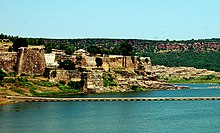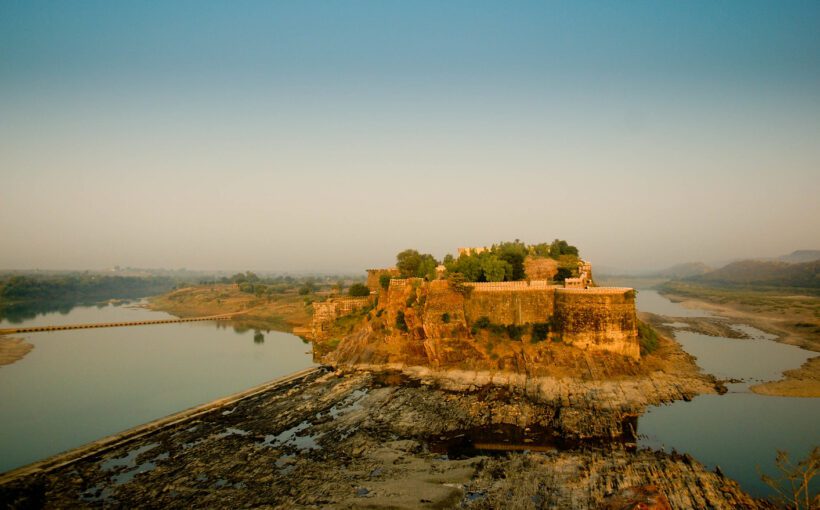The rich history of Rajputana and its tales of glory generates a sense of honor in the hearts of every Indian who reads it.
The titanic wars that shaped the history of Rajasthan, the culture which to this day remained prosperous, and the tradition of valor and sacrifice that astonishes every single soul of the sub-continent to this day have remained as a symbol of pride for the entire country. Many of us had heard the story of Queen Padmavati and her Jauhar when the Khilji forces attacked Mewar.

Queen Padmavati chose to perform Jauhar rather than becoming a slave to the invading forces. The sacrifice of her and other Rajput women gives us glimpses of Rajput’s ethics, ideals, and morale. But the Jauhar of Queen Padmavati was not the only one which took place in Rajputana.
In this article, we will delve into the untold story of the queen Lal Bai (Ruby of Mewar) and the two Jauhars of Gagraun. Gagraun fort which today is included in the UNESCO world heritage site also speaks its own tale of sacrifice. The fort which was conquered by many chiefs, sultans, and amirs had a vast and rich history of which most of the countrymen were unaware.
Just like Queen Padmavati who belonged to Mewar, there was another lady who belonged to the same family and later became the Queen of Gagraun fort. Lal Bai or Lal Kunwar Bai regarded as the Ruby of Mewar was the queen of the Gagraun fort. Many of us have not even heard her name but the history and bards of Rajasthan have kept alive her honor and sacrifice.
Content
Gagraun Fort: History and Origin
The fort of Gagraun is located in the present-day district of Jhalawar (Rajasthan). From its inception, the fort has witnessed the rise and fall of many empires. Enlisted in the UNESCO World Heritage Site the fort is surrounded by water from three sides and a dense forest from the fourth side.
The two rivers which surround the fort are the Ahu and the Kali-Sindh. That’s why it is also called the Water Fort. However, due to a lack of historical sources, the origin of this magnificent fort is not clear. Historians had suggested that the fort might been built in parts and with time several dynasties that ruled this fort added new portions to the fort.
The Kinchi Rajputs established their hegemony over the fort around the end of the 12th century CE. The Kinchi chief who captured the fort was named Devan Singh Kinchi who defeated the fellow Parmar ruler of the fort and ended their rule over the region. Monarchs like Maharana Sangram Singh aka Rana Sanga, Akbar, and Sher Shah Suri all had taken control over this fort during their period.

The fort of Gagron had witnessed several titanic battles and one of the most prominent ones took place in 1519 when Maharana Sanga of Mewar demolished the army of Mahmud Khilji II in the battle of Gagraun. But the most devastating encounters that changed the history of Gagraun were led by the Sultanate of Malwa.
The sultans of Malwa twice invaded the fort of Gagraun. Both these invasions ended with the Shaka and Jauhar of the brave Rajput men and women.
Malwa Sultanate
Referred as the Ghuri Sultanate the kingdom emerged to prominence under Dilavar Khan Ghuri who carved out an independent empire at Malwa. It was around the early 15th century when the sultan i.e. Dilavar Khan declared his independence.
Later he was succeeded by his son, Alp Khan or Hoshang (Hushang) Shah. The new sultan made Mandu his stronghold and even built a fort there loaded with an immense garrison. Initially, he came into conflict against the Gujarat Sultanate and was defeated by their sultan Muzaffar Shah.
However, later Hoshang Shah reestablished his control of Mandu and emerged as a powerful warlord in Malwa.
Lal Bai the Ruby of Mewar and First Jauhar of Gagraun
Rana Mokal was the son of Rana Lakha and his queen Hansabai. Rana Mokal ascended the throne of Mewar at an early age due to which Choonda the eldest son of Maharana Lakha aided the newly crowned king in the administration.
However, Hansa Bai the mother of Rana Mokal didn’t like the involvement of Choonda in the administration. She suspected that Choonda might grab the throne of Mewar in the near future. This belief of Hansa Bai made the guardian of Mewar i.e. Choonda disheartened and in return, he decided to leave Mewar for good.
Later Rana Mokal established his control over the region of Sambhar and maintained his authority over Mewar. He had three sons and a daughter named Lal Bai. Lal Bai was married to Achaldas the Kinchi Rajput of Gagron who made themselves the master of the fort of Gagron.
Rana Mokal had promised his daughter to protect Gagraun and its people from any foreign onslaughts. It was in 1423 when the moment finally came to fulfill his promise. In 1423 Hoshang Shah invaded Gagraun with a huge army of around 30,000 troops. At that time Gagraun was under the rule of Achaldas Kinchi.
The Rajputs at Gagraun were outnumbered and asked Rana Mokal for immediate aid. Rana Mokal loyal to his promise to his daughter assembled his Mewari forces and decided to stop the advance of Hoshang Shah. However, the help from Mewar couldn’t reach them as Chacha and Mera the two uncles of Maharana revolted against him. This revolt cost the Maharana his life and left the Rajputs at Gagraun alone.
Achaldas decided to offer battle despite being surrounded by the power-hungry invaders. It is believed that the Rajputs at Gagraun halted the attack of Hoshang Shah for about two weeks despite lacking military resources.
Later the invading army cut off the supply lines of Gagraun completely which made the Rajputs carry out the final battle. Achaldas and his men came out of the fort and fought till their last breath.
The women inside the fort decided to save their honor by committing Jauhar. Lal Bai and other Rajput women performed Jauhar following the code of the Rajputs and saved themselves from the clutches of slavery.
Second Jauhar of Gagraun
The Second time the fort of Gagraun witnessed the flames of Jauhar was in 1444 CE when Mahmud Khilji I attacked the region with a vast army. After the first Jauhar of Gagraun, the fort again came under the rule of the Kinchi (Khinchi) Rajputs. Palhansingh the son and successor of Achaldas reestablished the authority of the Rajputs at Gagraun.
It is believed that in 1437 Maharana Kumbha the most illustrious king of Mewar’s history crushed the forces of Mahmud Khilji I of Malwa sultanate in the battle of Sarangpur. Due to this defeat of the Malwa sultanate, the Kinchi Rajputs got sufficient time to relocate themselves at Gagraun in the year 1437 CE.
But in 1444 CE Mahmud Khilji I assembled his troops to establish his control over Gagraun. The battle was a hard-fought contest that ultimately resulted in the victory of Mahmud Khilji. Women committed Jauhar just like in 1423 CE and men fought to the last for the sake of their kingdom and for the pride of the centuries-old tradition of the Rajputs.
Many of us have heard and read the story of Queen Padmavati and her sacrifice but it is not the only tale that describes the bravery, chivalry, and morale of Rajput women. There are many women like Lal Bai who preserved their honor rather than become slaves of Sultans. The two Jauhar’s of Gagraun to this day speak the tale of the sacrifice of countless Hindu women.
LIKE WHAT WE ARE DOING? DONATE TO DHARMAYUDH
If you support what we are doing and would like to contribute to help us grow and reach more Indians to teach them more about such forgotten historic Indian Heroes and stories, please consider donating any amount. It will help us grow.

